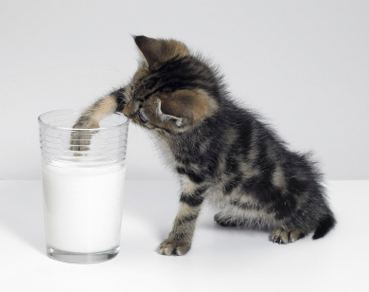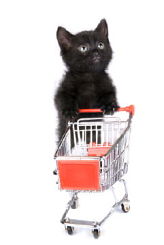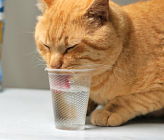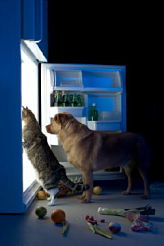Do you have a Milkaholic Cat?

Do you have a milkaholic cat? I think you know the type I’m talking about. You put down your bowl of cereal and in a flash, your cat is there, licking his chops and meowing piteously as he stares at you pleadingly. Or you pour milk into a glass just simply to drink and before you can get to it, his paw gets there first.
He may be a “milk-moocher” but he’s showing all the signs of a milkaholic cat. You may be tempted to give him his own daily dish of milk so he won’t keep trying to beat you to your bowl. But, don’t. Milk should be given sparingly…and only as a treat.
As tasty as milk is, it doesn’t amount to a balanced diet. While it does supply protein and calcium, it lacks many of the nutrients to stay healthy. If you give a cat too much milk, it’s going to fill up, and it won’t eat enough of its regular food.
Also, by letting your cat guzzle
milk to its heart’s content, you risk turning your little milkaholic
cat into a tubby cat. Everything has calories…except water. However,
if your cat is not fat, a small amount of low-fat milk (around 1-2
ounces or less) per day won’t do any harm.
For some cats, though, milk snacks can cause problems. Certain cats appear to lack the enzymes that break down milk sugar (lactose), making them lactose intolerant
…in the same manner as some people have this intolerance to lactose.
Unfortunately, when lactose doesn’t break down, it soaks up water as it
travels through the colon, and the end result is diarrhea. The
undigested lactose can also ferment…producing gas, bloating, and
discomfort.
It’s unclear how many cats are lactose intolerant, but even lactose-intolerant cats probably won’t have a problem if you keep their milk intake to a minimum. But if even a smidgeon of milk gives your cat indigestion…and you can’t get your furry little milkaholic cat to stop hollering for the milk in your cereal bowl…consider switching to lactose-reduced or lactose-free milk.
There are low-fat, lactose-free milks marketed specifically for cats and available from some supermarkets. The advantage of these products is that they come in small packages, so less is wasted. Also, the milk is usually ultra pasteurized , so you can store an unopened package at room temperature for several weeks prior to opening it. However, once you open it you have to refrigerate it and use it within a few days just like other milk types.
But if you drink milk yourself, and you don’t mind using lactose-reduced brands, there’s no need to pay extra on a special cat milk. While cat milks contain more of the amino acid taurine than regular dairy milk ( a necessity for cats), they don’t have enough to meet a cat’s daily requirement. Besides, your cat can get all of the taurine it needs from any high-quality commercial cat food.
Related Articles......
Return from Milkaholic Cat to Cat Health Homepage
Having trouble finding what you need? Cat Health Index & Site Map
OR
Do you have a question to ask?...Questions
OR
Do you have a cat story to share?...Simply click here to go to that page!
Copyright@2010-2020 All rights reserved.Cat-health-detective.com
This website is information only. Consult a veterinarian for medical assistance

"Like Us" on Facebook
or...
"Like Us" here




















